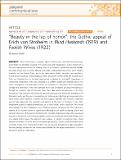"Beauty in the lap of horror" : the Gothic appeal of Erich von Stroheim in Blind Husbands (1919) and Foolish Wives (1922)
Abstract
This article revisits a seminal figure of film history, the director/actor/scriptwriter Erich von Stroheim, focusing on his early work, and arguing that a Gothic framework is the most appropriate context for making sense of his complex, subversive persona; equally, the essay shows how two films dealing with urban, sophisticated characters, set in modern locations such as Monte Carlo, are in fact drenched in Gothic sensibility and aesthetics. As the director and star of Blind Husbands (1919) and Foolish Wives (1922), the Austrian-born Erich von Stroheim has so far been analysed as a catalyst for post-WWI stereotypes of unwelcome foreignness in the USA. Irrupting in a context fraught with anxieties about “evil Huns”, immigration, and ambivalent notions of Europeanness, Stroheim’s films caused both outrage and admiration. While film scholars have read Stroheim’s perceived transgression through his symbolic role of Germanic alien, they have paid scant attention to the films themselves. This omission has effectively ignored other powerful evocations emerging from Stroheim’s work, and the way its suggestions of contemporary identities are subsumed into a much wider, richer narrative: a Gothic narrative. Equally, scholars have correctly mobilized, yet not fully addressed, the essential contradiction at the basis of Stroheim’s roles: their inexplicable quality of repulsion-attraction, or in other words, Gothic abjection. This article acknowledges the films’ linkability to post-WWI xenophobia, yet argues that their subversive aspects lie in a Gothic system of signification, allowing for yet vastly exceeding cultural and national references of the period; the Gothic also provides a framework where the unresolved tensions of Stroheim’s work can meaningfully coexist. Blind Husbands and Foolish Wives centre on a staple Gothic figure, the aberrant male seducer, a “satanic” protagonist who is both molester and object of erotic desire, irresistible yet repulsive. Visually and narratively reliant on Gothic tropes, from “sublimely horrible” mise-en-scene to intimations of rape and sadism, the films daringly validate not the merely objectionable, but the abject, embodied in Erich von Stroheim’s perverse masculinity.
Citation
Girelli , E 2017 , ' "Beauty in the lap of horror" : the Gothic appeal of Erich von Stroheim in Blind Husbands (1919) and Foolish Wives (1922) ' , Palgrave Communications , vol. 3 , 17082 . https://doi.org/10.1057/palcomms.2017.82
Publication
Palgrave Communications
Status
Peer reviewed
ISSN
2055-1045Type
Journal article
Collections
Items in the St Andrews Research Repository are protected by copyright, with all rights reserved, unless otherwise indicated.

